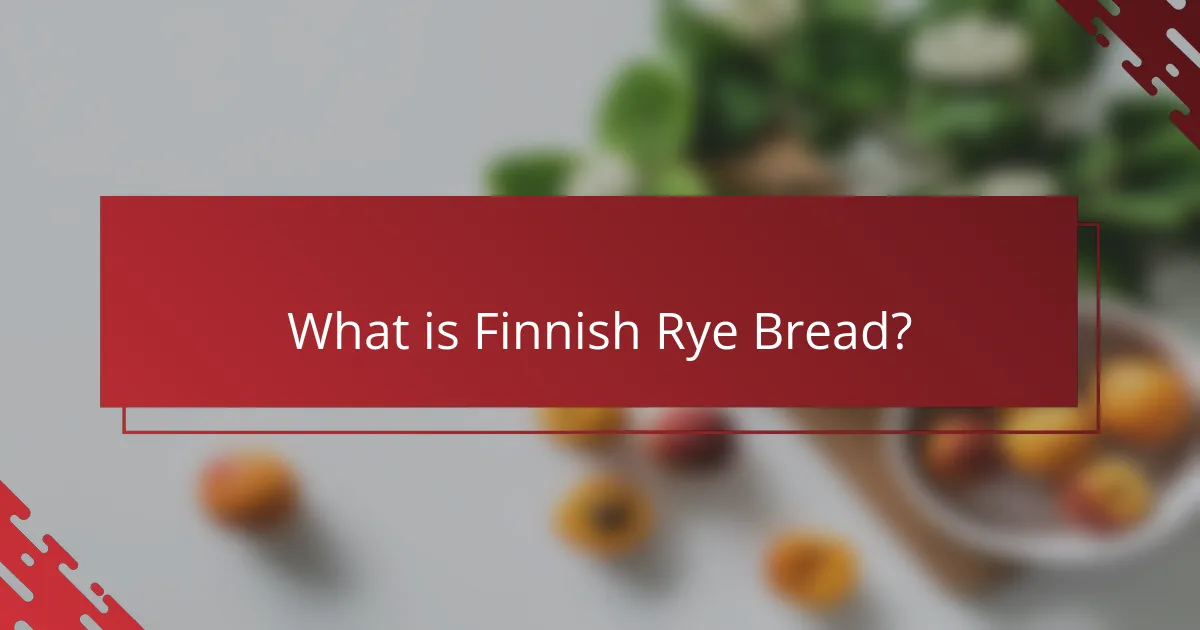Finnish rye bread is a traditional staple made primarily from rye flour, characterized by its dense texture, dark color, and slightly sour taste due to fermentation. This bread is commonly prepared using a sourdough starter and can take various forms, including round loaves and flatbreads. Key baking methods include traditional oven baking and steaming, both of which enhance the bread’s unique flavor and texture. Finnish rye bread is versatile in its serving options, often accompanied by butter, cheese, or smoked fish, and it holds cultural significance in Finnish cuisine, frequently enjoyed during festive occasions.

What is Finnish Rye Bread?
Finnish rye bread is a traditional bread made primarily from rye flour. It is dense and has a dark color, often with a slightly sour taste due to fermentation. This bread is a staple in Finnish cuisine and is known for its high fiber content. Rye bread is typically made using a sourdough starter, which enhances its flavor and texture. It can be found in various forms, including round loaves and flatbreads. Finnish rye bread has a long history, dating back centuries, and is often associated with rural Finnish life. It is commonly served with butter, cheese, or smoked fish, highlighting its versatility in meals.
How is Finnish Rye Bread different from other types of bread?
Finnish Rye Bread is distinct from other types of bread primarily due to its use of 100% rye flour. This flour gives the bread a dense texture and a rich, earthy flavor. Unlike wheat-based breads, Finnish Rye Bread typically has a lower gluten content, which affects its rise and chewiness. The traditional sourdough fermentation process used in Finnish Rye Bread enhances its flavor and extends its shelf life. Additionally, this bread often contains seeds or grains, such as caraway or flaxseed, adding nutritional value and taste. The unique combination of ingredients and methods makes Finnish Rye Bread a staple in Finnish cuisine, setting it apart from more common bread varieties.
What are the key characteristics of Finnish Rye Bread?
Finnish Rye Bread is characterized by its dense texture and rich flavor. It is primarily made from rye flour, which gives it a distinct taste. The bread often contains a sourdough starter, contributing to its tangy profile. Finnish Rye Bread is typically darker in color compared to wheat bread. It has a long shelf life due to the natural preservatives in rye. The bread is commonly enjoyed with butter, cheese, or fish. Its nutritional benefits include high fiber content and lower gluten levels. This type of bread is an essential part of Finnish cuisine and culture.
Why is rye flour used in Finnish Rye Bread?
Rye flour is used in Finnish Rye Bread primarily for its unique flavor and nutritional benefits. This flour contains more fiber and nutrients compared to wheat flour. The high fiber content aids in digestion and contributes to a lower glycemic index. Rye flour also provides a denser texture, which is characteristic of Finnish Rye Bread. Additionally, it contains a specific type of gluten that helps the bread maintain its shape while allowing for a moist crumb. Historically, rye has been a staple grain in Finland due to its ability to thrive in colder climates. This cultural significance further solidifies the use of rye flour in traditional Finnish bread recipes.
What are the traditional ingredients in Finnish Rye Bread?
The traditional ingredients in Finnish Rye Bread include rye flour, water, salt, and sourdough starter. Rye flour gives the bread its distinctive flavor and dense texture. Water is essential for hydrating the flour and activating the yeast. Salt enhances the taste and helps with fermentation. Sourdough starter provides natural leavening and contributes to the bread’s unique sour flavor. These ingredients have been used for centuries in Finnish baking traditions.
How does the choice of flour impact the flavor of Finnish Rye Bread?
The choice of flour significantly impacts the flavor of Finnish Rye Bread. Different types of rye flour contain varying levels of gluten and flavor compounds. Dark rye flour, for example, offers a richer, more robust flavor compared to light rye flour. Whole grain rye flour contributes to a nutty taste and denser texture. The fermentation process is also influenced by the flour type, affecting the sourness and complexity of the bread’s flavor. Additionally, the freshness of the flour can enhance or diminish flavor profiles. Using freshly milled flour typically results in a more vibrant taste. Therefore, selecting the right flour is crucial for achieving the desired flavor in Finnish Rye Bread.
What role do additional ingredients play in the recipe?
Additional ingredients enhance the flavor, texture, and nutritional profile of Finnish rye bread. They can introduce unique tastes, such as seeds or spices, which complement the earthy flavor of rye. Ingredients like molasses or honey add sweetness and moisture, improving the bread’s softness. Nuts and seeds provide crunch and additional health benefits, including healthy fats and protein. Furthermore, dairy products like buttermilk can create a tender crumb and enrich the bread’s taste. The inclusion of these ingredients can also affect the bread’s fermentation process, impacting its rise and overall structure. Each ingredient plays a specific role, contributing to the final product’s complexity and appeal.
What are the health benefits associated with Finnish Rye Bread?
Finnish Rye Bread offers several health benefits. It is high in dietary fiber, which aids digestion and promotes gut health. This bread type has a low glycemic index, helping to regulate blood sugar levels. Finnish Rye Bread is rich in essential nutrients, including B vitamins and minerals like magnesium. The presence of antioxidants in rye may help reduce inflammation. Additionally, it supports heart health by potentially lowering cholesterol levels. Studies suggest that whole grain rye consumption can improve satiety, assisting in weight management.
How does Finnish Rye Bread contribute to a balanced diet?
Finnish Rye Bread contributes to a balanced diet by providing essential nutrients and dietary fiber. It is rich in whole grains, which are beneficial for heart health. The high fiber content aids digestion and helps maintain stable blood sugar levels. Rye bread also contains important vitamins and minerals, including B vitamins, magnesium, and iron. Studies indicate that whole grain consumption is linked to a lower risk of chronic diseases. For example, research published in the American Journal of Clinical Nutrition shows that whole grain intake can reduce the risk of cardiovascular disease. This makes Finnish Rye Bread a nutritious choice for a balanced diet.
What nutrients are found in Finnish Rye Bread?
Finnish rye bread is rich in several essential nutrients. It typically contains dietary fiber, which aids in digestion. This bread is also a good source of complex carbohydrates, providing sustained energy. Finnish rye bread often contains protein, which is important for muscle repair and growth. Additionally, it includes various vitamins such as B vitamins, which support metabolism. Minerals like magnesium and iron are also present, contributing to overall health. The high fiber content can help lower cholesterol levels and improve heart health. Studies indicate that whole grain rye products can reduce the risk of chronic diseases.

What are the common baking methods for Finnish Rye Bread?
The common baking methods for Finnish Rye Bread include traditional oven baking and steaming. Oven baking involves using a preheated oven to achieve a crusty exterior and soft interior. This method typically requires a baking stone or tray to ensure even heat distribution. Steaming is often used in conjunction with oven baking. This technique helps to create a moist environment, enhancing the bread’s texture and flavor.
In Finland, rye bread is usually baked at temperatures ranging from 200 to 250 degrees Celsius. The use of sourdough starter is also prevalent, contributing to the bread’s distinctive taste. Many recipes call for a combination of whole grain rye flour and white rye flour. This blend affects the bread’s density and flavor profile.
Additionally, some bakers employ the method of using a Dutch oven. This traps steam effectively, resulting in a well-risen loaf. Each method contributes uniquely to the overall quality of Finnish Rye Bread.
How do traditional methods differ from modern techniques?
Traditional methods of baking Finnish rye bread involve hand-mixing and long fermentation times. These techniques emphasize natural leavening and the use of whole grains. Modern techniques often utilize commercial yeast and mechanical mixers for efficiency. This shift allows for shorter baking times and more consistent results. Traditional methods can enhance flavor complexity and texture. In contrast, modern techniques prioritize speed and convenience. Historical practices, like using sourdough starters, contribute to the bread’s unique taste. Studies show that longer fermentation improves the nutritional profile of rye bread.
What tools are essential for baking Finnish Rye Bread?
Essential tools for baking Finnish Rye Bread include a mixing bowl, a wooden spoon, and a baking sheet. A mixing bowl is necessary for combining ingredients. A wooden spoon helps in stirring the dense dough. A baking sheet is used for placing the formed bread before baking. Additionally, a kitchen scale is important for measuring flour accurately. A thermometer can help ensure the oven is at the right temperature. Finally, a bread knife is useful for slicing the finished loaf. These tools facilitate the traditional process of making Finnish Rye Bread effectively.
How does the fermentation process affect the bread’s texture?
The fermentation process significantly affects the texture of bread. During fermentation, yeast and bacteria produce carbon dioxide and organic acids. This gas creates bubbles in the dough, leading to a lighter and airier texture. The acids contribute to flavor and strengthen gluten structure. In Finnish rye bread, longer fermentation enhances chewiness and density. Research shows that fermentation time impacts crumb structure and moisture retention. A study by K. J. R. Vainionpää et al. (2019) found that extended fermentation improves the overall texture of rye bread.
What are the steps involved in baking Finnish Rye Bread?
To bake Finnish Rye Bread, first gather the necessary ingredients. These typically include rye flour, water, salt, and yeast. Next, mix the rye flour with water to form a dough. Allow the dough to rest for a period to enhance gluten development. After resting, knead the dough thoroughly. Shape the dough into a loaf and place it in a prepared baking pan. Let the shaped dough rise until it has doubled in size. Preheat the oven to the appropriate temperature, usually around 200°C (392°F). Finally, bake the bread for approximately 30 to 40 minutes, or until it sounds hollow when tapped on the bottom.
What is the importance of kneading in the baking process?
Kneading is essential in the baking process as it develops gluten in the dough. Gluten provides structure and elasticity, which are crucial for the texture of bread. Proper kneading ensures even distribution of ingredients, including yeast and salt. This process also helps to incorporate air, which aids in fermentation. Kneading typically requires 8 to 10 minutes of manual effort or mechanical mixing. Research shows that well-kneaded dough rises better and produces a lighter loaf. Therefore, kneading significantly impacts the quality of the final baked product.
How long should Finnish Rye Bread be baked for optimal results?
Finnish Rye Bread should be baked for approximately 30 to 40 minutes at a temperature of 200°C (400°F). This baking duration ensures a well-cooked interior and a crust that is both firm and flavorful. The bread is typically done when it has a deep brown color and sounds hollow when tapped on the bottom. Additionally, using a thermometer, the internal temperature should reach around 90°C (194°F) for optimal results.

How can Finnish Rye Bread be served and enjoyed?
Finnish rye bread can be served in various ways. It is commonly enjoyed with butter and cheese. Slices can be topped with smoked salmon or pickled herring. Finnish rye bread pairs well with soups and stews. It can also be used as a base for open-faced sandwiches. Traditional accompaniments include various meats and vegetables. The bread’s dense texture makes it ideal for hearty toppings. Rye bread is often served during festive occasions. Its unique flavor enhances both simple and elaborate meals.
What are popular serving suggestions for Finnish Rye Bread?
Popular serving suggestions for Finnish Rye Bread include pairing it with butter and cheese. Many enjoy it with smoked salmon or herring. It is often served alongside pickled vegetables. Traditional toppings also include cold cuts and spreads like liver pâté. Finnish rye bread is commonly used for open-faced sandwiches. It complements soups and stews well. The bread’s dense texture makes it ideal for hearty meals. These serving suggestions highlight its versatility in Finnish cuisine.
How can Finnish Rye Bread be paired with various toppings?
Finnish rye bread can be paired with a variety of toppings to enhance its flavor. Common toppings include butter, which adds richness. Cheese, such as Finnish cheese or aged gouda, complements the bread’s texture. Cold cuts like smoked salmon or ham provide a savory option. Pickled vegetables, such as cucumbers or beets, add acidity and crunch. Traditional spreads like herring salad or egg butter are popular choices. Each topping enhances the unique taste of rye bread, creating a balanced meal. The versatility of toppings allows for both traditional and modern interpretations.
What are traditional dishes that include Finnish Rye Bread?
Traditional dishes that include Finnish Rye Bread are rye bread sandwiches and ruispuuro. Rye bread sandwiches often feature fillings like cold cuts, cheese, or smoked fish. Ruispuuro is a porridge made from rye flour, commonly served with milk or butter. Another dish is kalakukko, which is a fish pie wrapped in rye bread. These dishes highlight the versatility of Finnish Rye Bread in various meals.
What are some tips for storing Finnish Rye Bread effectively?
Store Finnish Rye Bread in a cool, dry place. Wrap the bread in a clean kitchen towel or paper bag. This method helps maintain moisture while preventing mold. For longer storage, place the bread in a plastic bag and freeze it. Freezing can keep the bread fresh for up to three months. When ready to eat, thaw the bread at room temperature. Avoid refrigerating the bread, as this can dry it out. Proper storage can extend the shelf life of Finnish Rye Bread significantly.
How can you keep Finnish Rye Bread fresh for longer periods?
To keep Finnish Rye Bread fresh for longer periods, store it in a cool, dry place. Wrapping the bread in a clean, breathable cloth can help maintain moisture without making it soggy. Alternatively, place the bread in a paper bag to allow airflow while preventing excess moisture. For longer storage, consider freezing the bread. Slice it before freezing for easier access. When ready to eat, thaw the slices at room temperature. Research indicates that proper storage methods can extend bread freshness by several days to weeks.
What are the best practices for freezing Finnish Rye Bread?
To freeze Finnish Rye Bread effectively, wrap it tightly in plastic wrap or aluminum foil. This prevents freezer burn and maintains moisture. Place the wrapped bread in an airtight freezer bag for added protection. Label the bag with the date to track freshness. Freeze the bread in portions for easier thawing. To thaw, leave it at room temperature or toast slices directly from the freezer. Properly frozen, Finnish Rye Bread can last for up to three months while retaining its flavor and texture.
Finnish rye bread is a traditional staple made primarily from rye flour, characterized by its dense texture, dark color, and slightly sour taste due to sourdough fermentation. The article explores the unique attributes of Finnish rye bread, including its nutritional benefits, traditional ingredients, and common baking methods. It also highlights the differences between Finnish rye bread and other bread types, serving suggestions, and effective storage practices to maintain freshness. Key aspects such as the role of additional ingredients, fermentation effects on texture, and traditional versus modern baking techniques are discussed to provide a comprehensive understanding of this essential component of Finnish cuisine.